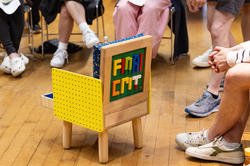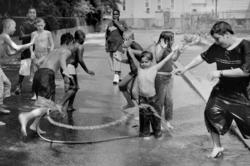The 2023–24 academic year comes to a close with final crits in studios across campus.
RISD Photography Studio Explores Notions of Space and Time

RISD faculty members not only teach students the technical skills they need to expand their artistic “toolkits,” but also help them develop creative practices encompassing those skills along with curiosity, historical research, experimentation and conceptually driven ideation. Students in a Photography department course called The Image in Space and Time are extending their creative points of view by working between still and moving images—as well as sculpture, performance and installation—and using space and time as both content and material.
Interdisciplinary artist Jessina Leonard MFA 20 PH developed the course and is calling on students to make a series of projects drawing upon the elasticity of image production. “They’re working toward creating a final, thoughtful and conceptually resolved installation that uses photography and/or film to engage space and time,” she says.
One of the requirements for the class, Leonard adds, is using multiple types of equipment, including resources available in the Microscopy and Advanced Imaging Lab, part of RISD’s Edna W. Lawrence Nature Lab. During an early fall visit, Senior Research Associate Georgia Rhodes and Technical Graduate Assistant Mary Connell introduced students to scanning electron microscopes, stereoscopes, compound microscopes and more. As Rhodes explained, this kind of cutting-edge equipment enables “direct, unmitigated observation of the natural world.”

The class is also developing a shared language for critiquing one another’s work through readings by contemporary artists and theorists like Hollis Frampton, Uriel Orlow, Laura Mulvey and Arthur Jafa. Becoming familiar with such photographic discourse is an important part of cultivating a broad understanding of the history and issues at play between still and moving images.
An early class assignment challenged the notion that photography is a view from nowhere that offers a passive, objective and infinite vision of the world (to paraphrase scholar Donna Haraway). Instead, Leonard encouraged the class to “rethink perception as unfixed, nonlinear, embodied and mobile.”
Each student created a three-dimensional, multimedia installation that engages with multiple, sometimes unexpected viewpoints. Sophomore Baek 27 PH, for example, constructed a photographic cube (see top image) reflecting on the ways that animals and insects see color. Junior Jiaolong Wang 26 ID/PH created an immersive installation mimicking the experience of looking up at the world from the bottom of a deep well.


The class gathered in the Photography department’s Red Eye Gallery to discuss the work. Junior Cole Miller 26 SC invited the group to sit on the floor in a darkened corner of the gallery almost like children gathered for a story. They passed around a beautiful book he created as a video projection close to the floor showed his experimental, grainy footage. One student described the changing depth of focus in the video as “slippery,” and another said the darkened room and pace of the piece evoked the tension that builds while watching a horror movie.
Junior Mitchell Tyler 26 PT also used darkness as a tool, presenting framed photographs lit only by a flickering jar candle. One student described the effect he created as intimate, and another was reminded of being inside a church. Another student noted that he could integrate the concept of time into the piece by using a tapered candle that would burn down during the viewing.
An untitled series of prints presented by Senior Brian Yoo 25 GD showed local restaurant workers with their faces scratched out. He explained that the subjects had simply requested not to have their images shared with the class, but Leonard and several others in the group could not escape the feeling of violence that the defaced images elicited. “I wonder if there’s another way to obscure the faces,” Leonard asked. “What if the images were hung face to the wall and you printed a transcription of your conversations on the backs?”
Discussions like this encourage students to consider how their photographic imagery exists within three-dimensional space and how they can continue to take risks and push boundaries in their work.
Top image: work by Baek; this and other pieces created in the class will be on view in the Red Eye Gallery, December 5–9, 2024.
Simone Solondz / photos by Kaylee Pugliese
November 4, 2024


